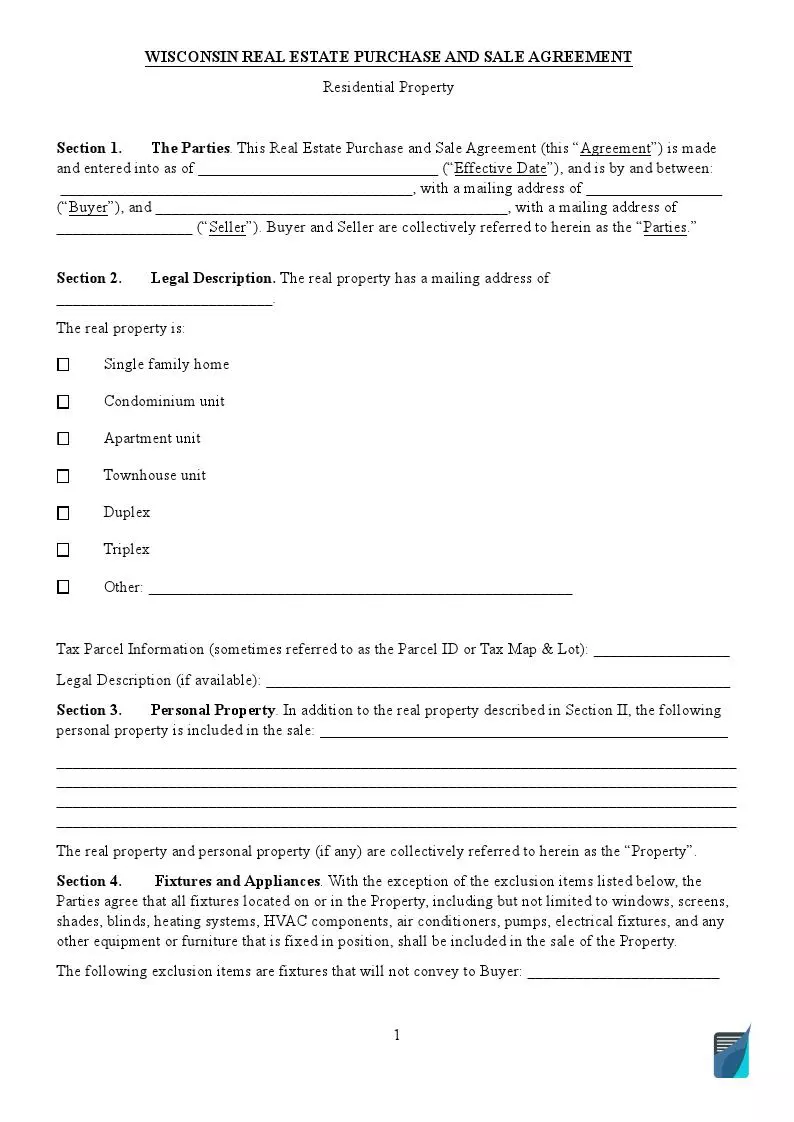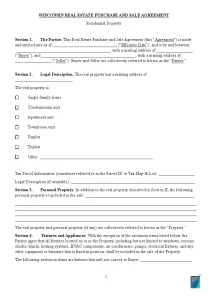Wisconsin Real Estate Purchase Contract
This document is of utmost importance as it is the primary document in the state that protects property buyers and sellers. Moreover, it gives both parties a clear understanding of the property and the possible legal perils that are extremely difficult to avoid once they decide to terminate the contract. It also contains detailed information and guarantees regarding the property’s condition.
Generally, it is an agreement between a real estate seller and acquirer containing the terms of the sale and acquisition of real property. Wisconsin Residential Purchase and Sale Agreement contains the mandatory information about the residence, including its description, pieces to be embodied in the sale (implements, pieces of furniture, etc.), along with other details, such as the sale price and mode of payment. You should fill in the fillable real estate purchase agreement exceptionally carefully, as you need to go through a lot of red tapes. It is also reasonable to hire an attorney after signing this.

Build Your Document
Answer a few simple questions to make your document in minutes
Save and Print
Save progress and finish on any device, download and print anytime
Sign and Use
Your valid, lawyer-approved document is ready
Wisconsin Residential Purchase and Sale Agreement
Ensure that you sign the contract: this step is very crucial in any state of the US. Let us have a look at the details contained in the Wisconsin residential purchase and sale agreement.
The details are:
- Basic information such as names of the buyer and their mailing addresses
- Type of the property (e.g., home, joint possession, planned unit development)
- Information on fixtures and personal belongings that come with the real estate
- The purchase price, advance money, interest rate, and closing costs
- Dates of closing
- Survey (information on possible defects of the property)
- Mineral rights
- Property conditions
- A list of required documents
- Buyer’s and seller’s defaults
- Ways of disputes’ resolution
- A list of disclosures and others
The seller must hand over the detailed condition report to the buyer within ten (10) days after accepting the offer. If the real estate is a joint possession and the report is obligatory, the seller has to attach an appendix with an in-depth description.
Unless the seller’s title is outlined in § 709.01(2), one must provide a detailed condition report regarding the property.
Wisconsin Commercial Purchase and Sale Agreement
The paper confirms the deal between an owner and a prospective buyer of commercial real estate. The buyer has to draft the commercial purchase and sale agreement. The conditions of the termination are also stated in the contract.
The main points are very similar to those in the Residential Purchase and Sale Agreement:
- General information about the parties
- Type of the property
- Bank and seller financing
- Inspection period
- Required disclosures
- Defaults
- Closing dates
- Settlement of disputes
If the owner/seller approves the contract, it instantly goes into effect. The buyer must state the conditions of the signed agreement.
Required Seller Disclosures in Wisconsin
The majority of sellers in this state must submit a condition report (read below). Without this disclosure attached, the agreement won’t have a binding effect. In most cases, it is required, and the exceptions are rare—owners of real estate with more than four dwelling units and sellers without actual experience of living there, functioning as representatives and all kinds of fiduciaries. If you don’t fall within these categories, take this obligation seriously.
Nevertheless, if there happen to be purposely hidden defects to increase the price, owners might be held responsible. Giving false information is punishable in many states, including Wisconsin.
1. Real Estate Condition Report
This report records the general condition of every room of the dwelling place. The seller must answer a wide range of questions about the residence to analyze and give information about all possible risks. The questions mainly concern defects of the structure and environmental issues. The rest of them concern various legal issues. There is a separate disclosure for lead-based paint, which is presented below. This form is essential and not very detailed. It doesn’t include any detailed information on repairs or valuation.
Sellers, except those in §709.01(2), should make a condition report within ten (or 10) days after accepting the offer.
2. Condominium Addendum to Real Estate Condition Report
If a joint property has to be provided with the condition report, there must be an appendix containing some additional information such as an item number, fees, or the name of the condominium.
3. Lead-based Paint Disclosure
This is an obligatory form for all dwellings constructed before 1978. The government prescribed this type of paint, as they estimated that the cracking and chipping had a harmful effect on the residents.
This form is designed to warn the dwellers against the possible negative consequences of this paint. If dwellers witness chipping or cracking of this kind of paint, they must report to the local authorities as promptly as possible.
To avoid such situations, landlords have to determine whether the house was built before 1978 at the local property auditor’s office or the department of buildings. If they have an intention to learn more about the topic, they may address the brochure called Protect Your Family From Lead in Your Home, which they can find in public access on the Internet.
Sellers of such residences must provide potential buyers with the document called Seller’s Disclosure of Lead-Based Paint. It informs them about the possibility of such hazardous effects.
To know even more on the subject, landlords may have an inspection by filling a form called EPA’s Inspection, Risk Assessment, and Abatement Firms Locator.
